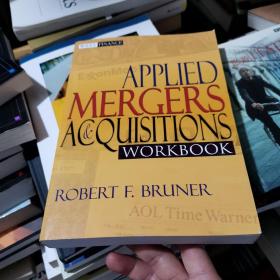
Applied Mergers And Acquisitions 9780471395058
外皮破损不影响观看
¥ 200 2.3折 ¥ 864 九品
仅1件
作者Robert F. Bruner 著
出版社Wiley
出版时间2004-03
版次1
装帧精装
货号423
上书时间2023-03-22
- 在售商品 暂无
- 平均发货时间 9小时
- 好评率 暂无
- 最新上架
商品详情
- 品相描述:九品
图书标准信息
- 作者 Robert F. Bruner 著
- 出版社 Wiley
- 出版时间 2004-03
- 版次 1
- ISBN 9780471395058
- 定价 864.00元
- 装帧 精装
- 开本 16开
- 纸张 胶版纸
- 页数 1028页
- 【内容简介】
- A comprehensive guide to the world of mergers and acquisitionsWhy do so many MandA transactions fail? And what drives the successof those deals that are consummated? Robert Bruner explains thatMandA can be understood as a response by managers to forces ofturbulence in their environment. Despite the material failure ratesof mergers and acquisitions, those pulling the trigger on keystrategic decisions can make them work if they spend great care andrigor in the development of their MandA deals. By addressing thekey factors of MandA success and failure, Applied Mergers andAcquisitions can help readers do this. Written by one of theforemost thinkers and educators in the field, this invaluableresource teaches readers the art and science of MandA valuation,deal negotiation, and bargaining, and provides a framework forconsidering tradeoffs in an effort to optimize the value of anyMandA deal. Applied Mergers and Acquisitions is part of a completesuite of resources on MandA that includes a workbook and a CD-ROMwith additional spreadsheets. Robert F. Bruner, MBA, DBA(Charlottesville, VA), is the Distinguished Professor of BusinessAdministration at the Darden School at the University of Virginiaand Executive Director of the Batten Institute. He directs theDarden School's executive education course on mergers andacquisitions, and teaches the popular MBA elective on that topic.He holds a BA from Yale University, and a MBA and DBA from HarvardUniversity.0471395064 A comprehensive guide to the world of mergersand acquisitions 0471395064 A comprehensive guide to the world ofmergers and acquisitions Why do so many MandA transactions fail?And what drives the success of those deals that are consummated?Robert Bruner explains that MandA can be understood as a responseby managers to forces of turbulence in their environment. Despitethe material failure rates of mergers and acquisitions, thosepulling the trigger on key strategic decisions can make them workif they spend great care and rigor in the development of theirMandA deals. By addressing the key factors of MandA success andfailure, Applied Mergers and Acquisitions can help readers do this.Written by one of the foremost thinkers and educators in the field,this invaluable resource teaches readers the art and science ofMandA valuation, deal negotiation, and bargaining, and provides aframework for considering tradeoffs in an effort to optimize thevalue of any MandA deal. Applied Mergers and Acquisitions is partof a complete suite of resources on MandA that includes a workbookand a CD-ROM with additional spreadsheets. Robert F. Bruner, MBA,DBA (Charlottesville, VA), is the Distinguished Professor ofBusiness Administration at the Darden School at the University ofVirginia and Executive Director of the Batten Institute. He directsthe Darden School's executive education course on mergers andacquisitions, and teaches the popular MBA elective on that topic.He holds a BA from Yale University, and a MBA and DBA from HarvardUniversity.
- 【作者简介】
- ROBERT F. BRUNER is the Distinguished Professor of BusinessAdministration at the Darden School of the University of Virginiaand Executive Director of the Batten Institute. He directs theDarden School's executive education course on mergers andacquisitions, and teaches the popular MBA elective on that topic.He is the author of over 250 case studies and a casebook, CaseStudies in Finance: Managing for Corporate Value Creation, whichhas been adopted for use at over 200 schools. Bruner's articleshave been published in the Journal of Financial Economics, theJournal of Accounting and Economics, the Journal of Financial andQuantitative Analysis, the Journal of Money, Credit, and Banking,and Financial Management. He has served as a consultant to overtwenty corporations as well as to the U.S. Government, and prior tohis academic career, worked as a commercial banker and venturecapitalist. Bruner holds a BA from Yale University, and an MBA andDBA from Harvard University.
- 【目录】
-
Foreword
Preface
PART ONE: INTRODUCTION AND KEY THEMES
CHAPTER 1: Introduction and Executive Summary "How Can My TeamDo Better Than the Averages?" A Framework for M&A Success
Seven New Big Ideas Worthy of the Best Practitioners
CHAPTER 2: Ethics in M&A Why Should One Care? In WhoseInterests? What Is Good?-Consequences, Duties, Virtues
Promoting Ethical Behavior
Greenmail Case: Walt Disney, 1984
CHAPTER 3: Does M&A Pay? The Measurement of M&AProfitability: Better Than What? Findings Based on the Analysis ofReturns to Shareholders
Findings Based on the Analysis of Reported FinancialPerformance
Findings about the Drivers of Profitability
Findings from Surveys of Executives
Findings from Clinical Studies
PART TWO: STRATEGY AND THE ORIGINATION OF TRANSACTIONPROPOSALS
CHAPTER 4: M&A Activity M&A Activity Appears inWaves
Explanations of M&A Activity
"Creative Destruction" as the Driver of M&A Activity
The Many Forms of Economic Turbulence, and Where to Look forIt
Turbulence Drives M&A Activities and Opportunities
CHAPTER 5: Cross-Border M&A Cross-Border M&AActivity
M&A within Regions and Trading Blocs
Drivers of and Returns from Cross-Border M&A
Strategic Analysis of Countries: Getting a "View." CHAPTER 6:Strategy and the Uses of M&A to Grow or Restructure the FirmSetting Strategy
Expansion by Inorganic Growth
Restructuring, Redeployment, and Sale
Choosing a Path
Does It Pay to Diversify or Focus the Firm? CHAPTER 7:Acquisition Search and Deal Origination: Some Guiding PrinciplesEight Principles of Acquisition Search
Case Study: Kestrel Ventures LLC
PART THREE: DILLGENCE, VALUATION, AND ACCOUNTING
CHAPTER 8: Due Diligence The Concept of Due Diligence
Principles and Strategies
Timing, Team, and Outputs
The Target's View: The Data Room and Its Pressures
Focus on Knowledge
Excellence in Due Diligence
CHAPTER 9: Valuing Firms Rule #1: Think Like an Investor
Rule #2: Intrinsic Value Is Unobservable; We Can Only EstimateIt
Rule #3: An Opportunity to Create Value Exists Where Price andIntrinsic Value Differ
Rule #4: So Many Estimators, So Little Time-It Helps to "Have aView." Rule #5: Exercise Estimators of Intrinsic Value to Find KeyValue Drivers and Bets
Rule #6: Think Critically; Triangulate Carefully
Rule #7: Focus on Process, Not Product
Rule #8: When in Doubt, see Rule #1
Valuation Case: Chrysler Corporation, March 1998
CHAPTER 10: Valuing Options Option Basics
Option Theory
Option Applications
A Practical Guide to Financial Option Valuation, with SomeImportant Caveats
CHAPTER 11: Valuing Synergies The Concept of Synergy
Synergy Estimates Must Be a Central Focus of M&AAnalysis
A Framework for Synergy Analysis
Estimating Synergy Value, with Examples
Synergies in the Daimler/Chrysler Merger
Rules of Thumb
CHAPTER 12: Valuing the Firm across Borders How Borders AffectM&A Valuation
Strategy for DCF Approach: Home versus Foreign Valuation
Adjusting Cash Flows
Estimating the Discount Rate
Recapitulation: Valuation Process with Adjusted CAPM
Valuation Cases across Borders
CHAPTER 13: Valuing the Highly Levered Firm, Assessing theHighly Levered Transaction The World of Highly Levered Firms
The Effect of Leverage on Firm Value
The "Whole Deal" Approach
A Case in Leveraged Recapitalization: Koppers Company
LBO Case: MediMedia International, Ltd
LBO Case #2: Revco Drug Stores
CHAPTER 14: Real Options and Their Impact on M&A Types ofReal Options
Where Real Options Appear in M&A
Why Not Value Everything as an Option? How to Assess the Impactof Real Options
Four Mini-Cases in the Analysis of Real Options
CHAPTER 15: Valuing Liquidity and Control Adjusting Values forDiscounts and Premiums
Where Do Illiquidity Discounts Come From? Where Do ControlPremiums Come From? Interaction of Liquidity and Control
Case Study: Volvo/Renault, 1993
CHAPTER 16: Financial Accounting for Mergers and AcquisitionsOverview of Purchase Accounting
How to Interpret Reported Financial Results from a BusinessCombination
Linkage among Accounting Choices, Form of Payment, Financing,and Price
Dangers of Earnings Management
CHAPTER 17: Momentum Acquisition Strategies: An Illustration ofWhy Value Creation Is the Best Financial Criterion Four CautionaryTales
Momentum Acquisition Strategies
The Arguments for and against Momentum Acquiring
Value Creation Is the Best Criterion for Evaluating AcquisitionStrategies
Momentum versus Value Strategies
PART FOUR: DESIGN OF DETAILED TRANSACTION TERMS
CHAPTER 18: An Introduction to Deal Design in M & A
Deal Structures Are Solutions to Economic Problems
Possible Desirables in Designing a Deal
Design Leads to Results
Each Deal Is a System: The "Whole Deal" Perspective
Some Implications for the Deal Designer
CHAPTER 19: Choosing the Form of Acquisitive Reorganization FiveKey Concerns for the Deal Designer
Deals That Are Immediately Taxable to the SellingShareholders
Deals That Defer Tax to the Selling Shareholders
CHAPTER 20: Choosing the Form of Payment and Financing Patternsand Trends in Form of Payment
Does Form of Payment Matter? Considerations in Selecting theForm of Payment
Assessing the Financing Aspects of a Deal
CHAPTER 21: Framework for Structuring the Terms of Exchange:Finding the "Win-Win" Deal A Model for Critically AssessingExchange Ratios
Uses and Illustration of the Model
Extension to Cash-for-Stock Deals
Choosing Exchange Ratio Targets in the "Win-Win" Zone
CHAPTER 22: Structuring and Valuing Contingent Payments inM&A Contingent Payments in M&A
Earnouts Can Be Useful; But If So, Why Aren't They Ubiquitous?Earnouts Are Options on Future Performance
Structuring an Earnout
Tax and Accounting Considerations
A Generic Approach to Valuing Earnout Instruments
The Eli Lilly Case
Proposing and Negotiating an Earnout and Other ContingentPayments
CHAPTER 23: Risk Management in M&A Value at Risk When a DealFails
Transaction Risk: Types and Sources
Types of Risk Management
Collars and Their Analysis
Contingent Value Rights Case
Staged Acquiring Case
Where and When to Manage Risk
CHAPTER 24: Social Issues The Importance of Social Issues inM&A
Survey of Social Issues
Impact of Social Issues on Attractiveness of the Deal
Case Studies in the Role of Social Issues
PART FIVE: RULES OF THE ROAD: GOVERNANCE, LAWS, ANDREGULATIONS
CHAPTER 25: How a Negotiated Deal Takes Place The Deal ShapingProcess
Risks: How the Process Can Get Derailed
Transaction Planning and Preparation
Initiating Discussions
First-Round Documents
The Definitive Agreement
Disclosures to Investors and Regulators
Gaining Approval
Case Study: Daimler-Benz and Chrysler
CHAPTER 26: Governance in M&A: The Board of Directors andShareholder Voting Governing Well Is Hard to Do
Good Governance Pays
How Shareholders Rule
Fiduciary Duties of Target Directors in Considering M&A
Preparing for the Board's Review of a Deal
How Can Firms Be Governed Better? CHAPTER 27: Rules of the Road:Securities Law, Issuance Process, Disclosure, and Insider TradingOverview of Key Securities Laws and Rules
International Law Comparison
Disclosures
Insider Trading
Observance of Deal Process
CHAPTER 28: Rules of the Road: Antitrust Law Antitrust Law:History and Motives
How Antitrust Regulators and Laws Affect M&A
U.S
Antitrust Merger Guidelines
Premerger Review Process in the United States
Antitrust Regulation of M&A in the European Union
Critical Perspectives on Antitrust Policy
CHAPTER 29: Documenting the M&A Deal First-RoundDocuments
Definitive Agreement
Merger Proxy Statement and Prospectus
PART SIX: COMPETITION, HOSTILITY, AND BEHAVIORAL EFFECTS INM&A
CHAPTER 30: Negotiating the Deal The Relevance of NegotiationProcess
Behavioral Finance
Influencing Bargaining Outcomes: An Overview of theChallenge
How to Prepare for a Negotiation
Managing the Negotiation Process Proactively
CHAPTER 31: Auctions in M&A Auction Structures andMotives
Advantages and Disadvantages of Auctions
Auctions in Practice: The Case of RJR Nabisco
The "Winner's Curse" in M&A: Is It Real? Some PracticalAdvice to Sellers in Auctions
CHAPTER 32: Hostile Takeovers: Preparing a Bid in Light ofCompetition and Arbitrage Takeovers Are Games
A Profile of Hostile Takeovers
Beware of the Players, Both on the Field and Off
The Arb Is the Consummate Economic Actor
Interpreting Arbitrage Spreads
The Arb Assesses a Recapitalization Proposal in Terms of BlendedValue
Government Constraints on the Game
Selling Shareholders Face a Prisoner's Dilemma
To Set a Bid Price: Think Like an Investor
The Game Has Implications for Design and Defense ofTakeovers
CHAPTER 33: Takeover Attack and Defense The Prevalence ofAntitakeover Defenses
Profile of the Target of a Hostile Bid
Optionality in Takeover Attack and Defense
Tactics of Takeover Attack
Tactics of Takeover Defense
Implications for the Practitioner
CHAPTER 34: The Leveraged Restructuring as a Takeover Defense:The Case of American Standard The American Standard Case
The Response
Of Parachutes, Pills, and Litigation
Restructuring Defenses
When Does a Restructuring Make Sense? PART SEVEN: Communication,Integration, and Best Practice
CHAPTER 35: Communicating the Deal: Gaining Mandates, Approvals,and Support Core Challenges to Effective Communication
Some Guiding Principles for Communicating the Deal
Presenting the "Concept Proposal." Communicating the Deal to theBoard for Approval
Communicating with Employees
Announcing the Deal to the Public
CHAPTER 36: Framework for Postmerger Integration IntegrationStrategy
Implementation of Integration Strategy
The Case of Union Bank of Switzerland and Swiss BankCorporation
Integration as Transformation
CHAPTER 37: Corporate Development as a Strategic Capability: TheApproach of GE Power Systems Business Development at GE PowerSystems
Deal Process at GE Power Systems
The M&A "Factory": Operationalizing Business Development
Implications for Best Practice
CHAPTER 38: M&A "Best Practices": Some Lessons and NextSteps Some Elements of M&A Best Practice
Where the Sidewalk Ends
Developing Best Practitioners
The End of It All
About the CD-ROM
Ref...
相关推荐
-

Applied Mergers And Acquisitions
九五品北京
¥ 120.00
-

Applied Mergers And Acquisitions
九品北京
¥ 180.00
-

APPLIED MERGERS&ACQUISITIONS
八品上海
¥ 160.00
-

Applied Mergers And Acquisitions
九品北京
¥ 200.00
-

Applied Mergers and Acquisitions
九五品大连
¥ 285.00
-

APPLIED MERGERS & ACQUISTIONS
九品北京
¥ 489.00
-

Applied Mergers And Acquisitions 9780471395058
九五品廊坊
¥ 360.00
-

Applied MERGERS & ACquisitions Workbook
九品北京
¥ 100.00
-

Applied Mergers And Acquisitions 9780471395058
九品廊坊
¥ 350.00
-

Applied Mergers And Acquisitions 9780471395058
九品廊坊
¥ 360.00
— 没有更多了 —




















以下为对购买帮助不大的评价